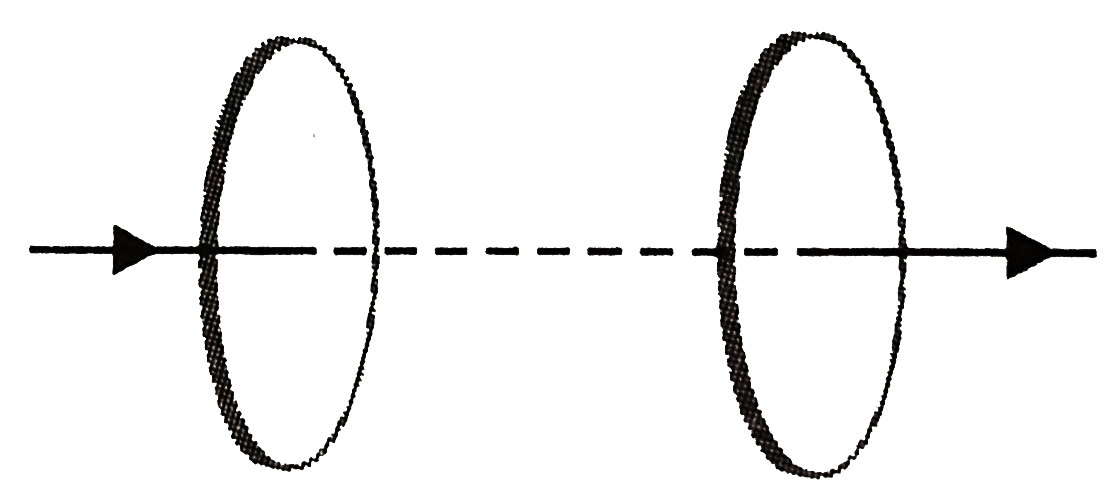Figure shows a capacitor made of two circular plates each of radius 12cm, and separated by 5.0cm. the capacitor is being charged by an external source (not shown in the figure). The charging current is constant and equal to 0.15A
(a) Calcuate the capacitance and the rate of change of potential difference between the plates
(b) Obtain the displacement current across the plates
(c) Is kirchhoff's first rule(junction rule) vaild at each plate of the capacitor ? Explain.
 .
.
1.873×107V/s
1.873×108V/s
1.873×109V/s
1.873×1010V/s
The correct Answer is:c
dVdt=1c=I.dAε0=1.87×109V/s
Topper's Solved these Questions
- BOOK - A2ZCHAPTER - ELECTROMAGNETIC WAVES AND COMMUNICATION SYSTEM EXERCISE - Problems Based On Mixed Concepts39videos
ELECTROMAGNETIC WAVES AND COMMUNICATION SYSTEM
- BOOK - A2ZCHAPTER - ELECTROMAGNETIC WAVES AND COMMUNICATION SYSTEM EXERCISE - Section B - Assertion Reasoning13videos
ELECTROMAGNETIC WAVES AND COMMUNICATION SYSTEM
- BOOK - A2ZCHAPTER - ELECTROMAGNETIC WAVES AND COMMUNICATION SYSTEM EXERCISE - Section D - Chapter End Test30videos
ELECTROMAGNETIC WAVES AND COMMUNICATION SYSTEM
- BOOK - A2ZCHAPTER - ELECTROMAGNETIC INDUCTIONEXERCISE - Section D - Chapter End Test30videos
ELECTROMAGNETIC INDUCTION
- BOOK - A2ZCHAPTER - GEOMETRICAL OPTICSEXERCISE - Section D - Chapter End Test30videos
GEOMETRICAL OPTICS
Similar Questions
Figure 8.01 shows a capacitor made of two circular plates each of radius 12 cm, and separated by 5.0 cm. The capacitor is being charged by an external source (not shown in the figure). The charging current is constant and equal to 0.15 A.
(a) Calculate the capacitance and the rate of charge of potential difference between the plates.
(b) Obtain the displacement current across the plates.
(c) Is Kirchhoff.s first rule (junction rule) valid at each plate of the capacitor? Explain.
 View Solution
View SolutionFig. shows a capacitor made of two circular plates each of radius 12 cm and separated by 5.0mm. The capacitor is being charged by an external source (not shown in the figure). The charging current is constant and equal to 0.15A.
(a) Calculate the capacitance and the rate of change of potential difference between the plates.
(b) Obtain the displacement current across the plates.
(c) Is Kirchhoff's first rule valid at each plate of the capacitor ? Explain.
 View Solution
View Solution
Knowledge Check
- Question 1 - Select One
A capacitor made of two circular plates each of radius 12 cm and separated by 5 mm. The capacitor is being charged by an external source. The charging current is constant and equal to 0.15 A. The capacitance of the parallel plate capacitor is
 A40 pFB45 pFC70 pFD80 pF
A40 pFB45 pFC70 pFD80 pF - Question 2 - Select One
A parallel plate capacitor consists of two circular plates each of radius 12cm and separated by 5.0mm. The capacitor is being charge by an external source. The charging current is constant and is equal to 0.15 A. The rate of change of potential difference between the plate will be
A8.173×107Vs−1B7.817×108Vs−1C1.173×109Vc−1D3.781×1010Vs−1
A parallel plate capacitor made of two circular plates each of radius 10 cm and separated by 4.0mm. The capacitor is being charged by an external source. The charging current is constant and equal to 0.10A. Calculate (i) the capacitance (ii) the rate of change of potential difference between the plates (iii) the displacement current.
View SolutionA capacitor consists of two circular plates each of radius 8.0 cm and separated by 3.0 mm. The capacitor is being charged by an external battery. The charging current is constant and is equal to 0.3 A. Calculate (i) capacitance of capacitor, (ii) the rate of change of potential difference across the plates of capacitor and (iii) the displacement current.
View Solution(a) Fig shows a capacitor made of two circular plates each of radius 12cm and separated by 5.0mm. The capacitor is being charged by an external source (not shown in the figure). The charging current is constant and equal to 0.15A. Use Ampere's law (modified to include displacement current as given in the text) and the symmetryin the problem to calculate magnetic field between the plates at a point (i) on the axis (ii) 6.5 cm from the axis (iii) 15cm from the axis.
(b) At what distance from the axis is the magnetic field due to displacement current greatest? Obtain the maximum value of the field. View Solution
View SolutionA parallel plate capacitor has two circular plates each of radius 5 cm separated by a distance of 3 m m . The capacitor current of 6 A is delived to it , find
(a) The capacitance
(b ) The rate of change of potential difference across the plates
(c ) the displacement current .View SolutionA capacitor, made of two parallel plates each of plate area A and separation d, is being charged by an external ac socurce. Show that the displacement current inside the same as the current charging the capacitor.
View SolutionA parallel plate capacitor is made out of two rectangular metal pates of sides 30cm×15cm and separated by a distance of 2.0 mm. The capcitor is charged in such a way that the charging current has a constant value of 100mA. What must be the rate of change of potential of the charging source to ensure this and what will be the displacement current in the region between the capacitor plates?
View Solution
